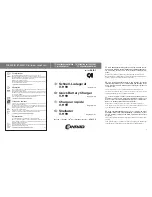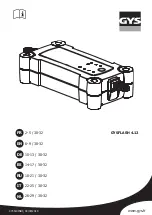
Elimination
Jetez le chargeur rapide devenu inutilisable (irréparable) conformé-
ment aux dispositions de recyclage en vigueur.
Guide de dépannage
En achetant le chargeur rapide V-1199, vous avez fait l’acquisition
d’un produit qui a été construit selon les derniers progrès de la
technique moderne et qui est fiable. D’éventuels problèmes ou
anomalies pourraient cependant survenir.
Nous décrivons ci-dessous comment parer vous-même à ces
dérangements.
Tenez absolument compte des consignes de sécurité.
Anomalie
Proposition de solution
Pas d'affichage de charge
Le chargeur est-il branché au sec-
teur ?
Est-ce que l’accu est défectueux (à
haute impédance, coupé) ?
Les contacts du chargeur ou de
l’accu sont-ils encrassés/oxydés ?
Attention !
- A l'ouverture des couvercles ou lors de l’enlèvement d’autres
parties, sauf celles pouvant être enlevées à la main, des par-
ties sous tension peuvent être mises à nu. Il est également
possible que des points de raccordement soient mis à nu.
- Les condensateurs dans l’appareil peuvent conserver des
charges, même si l’appareil a été déconnecté de toute source
de tension et de tout circuit de mesure.
34
When charging batteries please observe the charging instructions of
the particular battery manufacturer.
Improper use (too high charging currents or wrong polarity) can cau-
se the battery to overload or destroy it. In the worst case, the battery
may explode and cause considerable damage.
When working with power supply units or charging devices do not
wear metallic or conducting jewellery, such as bracelets, rings etc.
Power supply units and charging devices are not approved for use
with humans or animals.
Keep transmitting stations (wireless phones, transmitting stations
for model making etc.) away from the charging device. The radiation
emitted by the transmitting station can interfere with the charging
process or destroy the charger and also the batteries.
Defective batteries or batteries that cannot be recharged anymore
must be regarded as special waste and must be disposed of in spe-
cial collecting centres and do not belong in the household waste.
If there is reason to believe that safe operation is no longer possible,
the device must be put out of operation and must be secured
against unintended operation! It can be assumed that safe operati-
on is no longer possible if:
- the device no longer works
- the device shows visible damages,
- the device was stored under unfavourable conditions for a long
period of time,
- the device was subject to considerable transport stress.
Do no connect your charger to the mains directly after it was bro-
ught from a cold into a warm room. Condensing water that forms
19










































